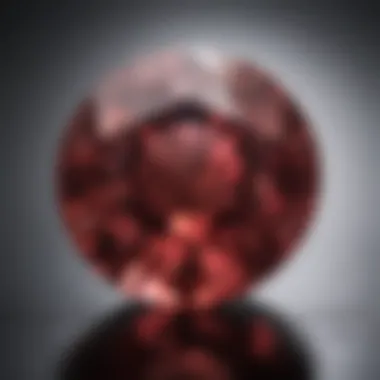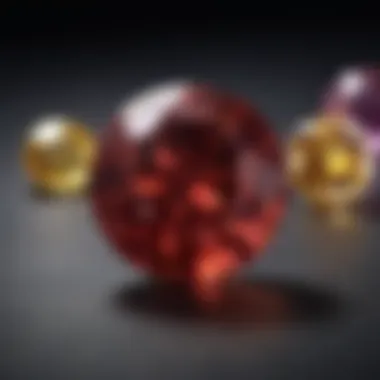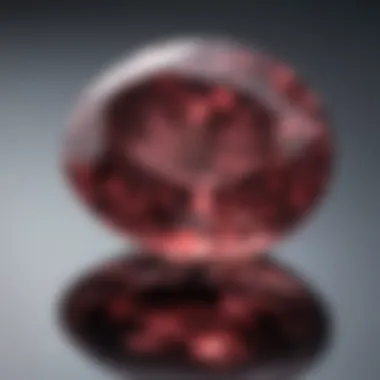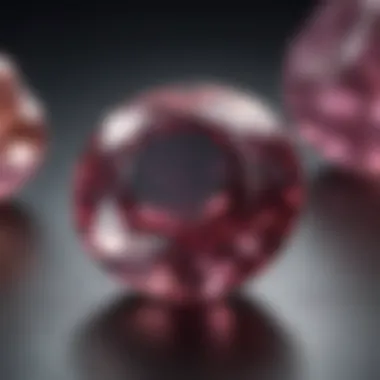Exploring the Significance of June 7th Birthstones


Intro
The June 7th birthstone emanates profound beauty and significance, drawing interest from both gemstone enthusiasts and the curious alike. This exploration centres on two essential stones associated with this date: pearl and alexandrite. Each gem carries its unique narratives, steeped in history and adorned with various cultural meanings.
Understanding these gemstones requires a close look into their attributes, properties, and the deeper connections they foster. Analyzing their impacts on individual lives can reveal the broader implications they hold across different cultures and eras. This article endeavors to offer insights into the color, qualities, and significance attached to pearls and alexandrites, enriching readers’ appreciation of these mesmerizing stones.
As we navigate through the characteristics of these birthstones, it is essential to comprise a foundation on gemstones in general. A detailed overview ensures a holistic understanding of where pearls and alexandrites fit within the wider realm of gemstones.
Gemstone Overview
Definition and Characteristics
Gemstones are naturally occurring minerals, often cut and polished for use in jewelry. They are typically chosen for their beauty, rarity, and durability.
Pearl, formed within the soft tissue of mollusks, is quite unique among gemstones. Unlike most, pearls do not require cutting or polishing. Their lustrous appearance is due to layers of aragonite and conchiolin, creating a shimmering effect.
On the other hand, alexandrite is a variety of chrysoberyl, known for its striking color-changing ability. Under daylight, it appears green, while incandescent light reveals a red hue. This unique characteristic often captivates collectors and jewelers alike.
Classification of Gemstones
Gemstones can be classified into two broad categories: precious and semi-precious.
- Precious gemstones include diamonds, rubies, sapphires, and emeralds. These are rare and often valued highly in the market.
- Semi-precious gemstones encompass a wider array of stones, including amethyst, garnet, and of course, pearls and alexandrite.
Ultimately, the classification reflects both mineral rarity and the market's perception. Both pearl and alexandrite hold a revered position, especially in the context of June birthstones, inviting exploration into their distinctive properties.
Properties of Gemstones
Physical Properties
Physical properties of gemstones are essential in their identification and valuation.
- Pearl: The aesthetics of pearls include their luster, color, and shape. Pearls usually appear in shades of white, cream, and even silver or pink. Their smooth, rounded shapes are often considered perfect.
- Alexandrite: Alexandrite exhibits notable hardness, rated at 8.5 on the Mohs scale. Its color variations add to its charm and desirability.
Chemical Properties
The chemical composition of these stones is equally significant in defining their identity.
- Pearl consists mainly of calcium carbonate, encapsulated within organic material.
- Alexandrite is composed of chrysoberyl, featuring beryllium and aluminum in its makeup.
These properties offer deeper insight into their formation and characteristics, connecting them to broader geological processes. Understanding the intricate details of these stones enriches one’s connection to them, whether for personal or professional interest.
"Gemstones are not merely decorations; they represent centuries of history and tales that link mankind to nature."
By grasping their essence and attributes, one can appreciate not only the aesthetic beauty of pearls and alexandrites but also their enduring significance in human culture and personal symbolism.
Preamble to Birthstones
Birthstones hold a unique place in human culture and personal identity. In this article, the focus is on the specific birthstones associated with June 7th, exploring their significance, characteristics, and the profound meanings they convey. Understanding birthstones can enhance appreciation for these gemstones, whether they are worn as jewelry or collected as treasures.
People often select birthstones to represent their personality, birth month, or even significant life events. This practice can foster a deeper emotional connection to the stones. Moreover, birthstones are frequently gifts, symbolizing thoughtful consideration of the recipient's individuality. The importance of each birthstone varies by cultural context, from traditional beliefs to modern interpretations of their qualities and virtues.
By exploring these stones further, we not only gain insights into their physical aspects but also the metaphysical and historical narratives surrounding them. For enthusiasts and collectors alike, the layers of meaning within each birthstone expand its significance beyond mere aesthetics. Hence, understanding the birthstones of June, particularly the pearl and alexandrite, serves as a conduit to delve into themes of identity, history, and spirituality.
Historical Context
The tradition of birthstones has roots in ancient cultures. The earliest record can be traced back to biblical texts, suggesting that the twelve stones in the Breastplate of Aaron correspond to the twelve tribes of Israel. Each stone held its unique meaning and significance. Over centuries, these ideas evolved as various cultures embraced the concept, leveraging gemstones as symbols for astrological signs and birth months.


In Western history, the modern list of birthstones was officially established in 1912 by the American National Retail Jewelers Association. This codification helped standardize the selection of birthstones, allowing consumers to understand what each gemstone represented. Variations exist in different cultures, such as the alternative birth stones recognized in India and other regions, which may differ in monthly associations.
Modern Interpretations
Today, birthstones are more than just cultural artifacts; they embody personal and emotional significance. Many people believe that each gemstone offers specific protective and healing qualities. The popularity of birthstones has led to diverse interpretations. For instance, pearls, often representative of purity and wisdom, are now frequently linked with themes of sophistication and timeless elegance.
Alexandrite, known for its unique color-changing abilities, symbolizes adaptability and balance. In modern jewelry, these stones are often custom-set in designs that reflect individual style.
The resurgence of interest in gemstones, due in part to social media platforms, has reinvigorated discussions about the qualities and meanings attributed to birthstones. As consumers become more informed, they seek out unique ways to incorporate these stones into their lives, whether through personal adornment, gifts, or even in the realm of holistic healing.
The June Birthstones
The month of June features two distinct gemstones, each with unique qualities and histories that are significant both culturally and personally. First, the pearl, often regarded as a classic choice, symbolizes purity and innocence. Its formation from the ocean represents a unique natural process, making each pearl a one-of-a-kind creation. On the other hand, alexandrite stands out due to its remarkable ability to change color under different lighting conditions. This phenomenon not only captivates observers but also enhances the stone's rarity and desirability in the market. Understanding the significance of these birthstones provides insight into how they can enrich one’s personal identity and symbolism.
Pearl: The Classic Choice
Pearls have been treasured for thousands of years. This gemstone, unlike most others, is organic, formed inside mollusks. Its cool, lustrous surface has inspired numerous myths and legends. These gems come in various types, including Akoya, Tahitian, and South Sea pearls, each offering distinct colors and shapes.
The color of pearls ranges from white to pink, lavender, and even black, depending on the species of the mollusk and the environment in which they grow. The traditional white pearl, for example, is often associated with elegance and refined taste.
Their beauty is not simply aesthetic. Throughout history, pearls have been connected to various cultural beliefs. In many cultures, they signify purity and are often gifted during significant life events, such as weddings or anniversaries. Their attribute of bringing calmness makes them popular among those who seek emotional stability.
While selecting pearls, it is crucial to consider factors like luster, surface quality, and shape, which determine their value. A well-chosen pearl can enhance one’s jewelry collection significantly.
Alexandrite: The Color-Changer
Alexandrite is a unique gemstone known for its ability to shift colors dramatically. In daylight, it may appear a vibrant green or bluish-green, transitioning to a rich red or purplish-red under incandescent light. This captivating quality is a result of its chemical composition, primarily consisting of chrysoberyl, a mineral that exhibits pleochroism.
This stone started to gain popularity in the early 19th century. It was discovered in Russia's Ural Mountains and was quickly named after Tsar Alexander II. The rarity and spectacular color changes make alexandrite one of the most sought-after gemstones today. Collectors and enthusiasts highly value its unique features, making it a focal point in both jewelry design and investment circles.
Understanding alexandrite’s characteristics requires an appreciation for its formation and the geological processes any gemstone undergoes. Alexandrite encourages growth and transformation, offering symbolic significance for individuals experiencing change in their lives. Thus, wearing this gemstone often resonates with concepts of adaptability and flexibility.
Pearl: Characteristics and Color
Understanding pearls is essential for appreciating their value in both aesthetics and cultural significance. Their unique formation process and varying color characteristics give pearls a distinct identity among gemstones. They have captured human interest and admiration for centuries, becoming symbols of purity, beauty, and even wealth. This section will explore the formation of pearls and the various colors they can exhibit, emphasizing their importance in the narrative of June's birthstones.
Formation and Types
Pearls form within the shells of certain mollusks, primarily oysters and mussels. When an irritant, such as a grain of sand, enters the shell, the mollusk reacts by secreting layers of nacre, a combination of aragonite and conchiolin. Over time, this accumulation creates a pearl. The essence of pearl production can be as intricate as it is beautiful, often taking several years for a pearl to fully develop.
There are several types of pearls based on their origin:
- Natural Pearls: These occur without human intervention and are extremely rare. They are formed in wild mollusks and can have irregular shapes.
- Cultured Pearls: Most pearls on the market today are cultured. They are produced using a similar process to natural pearls, but with human intervention to introduce the irritant.
- Freshwater Pearls: Grown in freshwater mussels, these pearls tend to have unique shapes and often come in a variety of colors.
- Saltwater Pearls: These pearls generally come from oysters and include famous varieties like Akoya, South Sea, and Tahitian pearls. They are often more uniform in shape and size than freshwater versions.
Pearls' varying formations and types contribute to their unique characteristics, making them a subject of fascination in the realm of gems.
Color Variations and Their Significance
The color of pearls is influenced by several factors, including the type of mollusk, the water environment, and the layers of nacre produced. Pearls can come in a dazzling range of colors such as white, cream, pink, silver, and even black.
- White Pearls: Often associated with purity and innocence, white pearls are classic and timeless. They are most prevalent in the Akoya variety.
- Pink and Rose Pearls: These hues symbolize love and compassion, playing a significant role in various cultures, especially in romantic contexts.
- Black Pearls: Typically from the black-lipped oyster, these pearls are rare. They are seen as symbols of mystery and are often considered exotic.
- Golden Pearls: Sourced from the gold-lipped oyster, these reflect wealth and luxury, frequently used in high-end jewelry.
"The allure of pearls lies not just in their beauty but also in their diverse colors, each offering a unique symbolism and connection to different values."
Understanding the significance of pearl colors enriches appreciation and selection when it comes to jewelry design. Each color variation carries meaning and resonates with personal beliefs, making pearls not just adornments but representations of deeper values.
Alexandrite: Unique Aspects


Alexandrite holds a prominent place in the world of gemstones, particularly for those born in June. Its unique properties make it a captivating subject that invites deeper exploration. This section will delve into two main aspects: the scientific composition of alexandrite and its color change phenomenon, both of which contribute to its allure and significance.
Scientific Composition
Alexandrite is a variety of the mineral chrysoberyl and is primarily composed of beryllium aluminum oxide. Its chemical formula is BeAl2O4, and this distinctive composition is responsible for its remarkable properties, including its fascinating color change abilities. Alexandrite contains trace amounts of chromium, which contribute to its unique play of colors. The presence of chromium ions in the crystal lattice allows the light to interact in complex ways, producing vibrant shades of green and red depending on the lighting conditions.
- Key elements of alexandrite's composition include:
- Beryllium
- Aluminum
- Chromium
These elements are not only crucial in defining the gemstone's physical attributes but also its rarity and value in the market. Understanding the scientific makeup of alexandrite enhances its significance, especially for collectors and enthusiasts who appreciate the complexities of gemstones.
Color Change Phenomenon
One of the most fascinating characteristics of alexandrite is its ability to change color. Under daylight, it typically displays a striking green hue. However, under incandescent light, it can shift to a reddish-purple or even a brownish tone. This phenomenon is known as pleochroism, which is the ability of a material to show different colors when viewed from different angles, particularly under varying light sources.
"Alexandrite’s color change is not just a visual treat; it symbolizes adaptability and transformation."
The dramatic shift in color makes alexandrite highly sought after. Many individuals believe that this symbolic nature reflects personal growth and change. Such interpretations resonate with gemstone enthusiasts, not just for the beauty of the stone but also for its deeper meanings in personal journeys.
Cultural Significance of June Birthstones
Understanding the cultural significance of June birthstones provides insight into their historical relevance and ongoing popularity. Pearls and alexandrite not only represent the month of June but also have deep roots in tradition, stories, and symbolism. Each stone carries meanings that resonate with various cultures and societies, showcasing their role in rituals, celebrations, and personal expressions.
Pearls in History
Pearls have a long and illustrious history, often revered for their beauty and rarity. Historically, they were associated with purity and perfection. In many ancient cultures, pearls were considered invaluable gifts from the sea, embodying the essence of femininity. For example, in ancient Rome, pearls were a status symbol among the elite.
- Persian royalty often adorned themselves with pearls, believing they conferred power and wisdom.
- Chinese legends held that pearls were formed from the tears of mythical creatures, highlighting their connection to deep emotions.
During the Middle Ages, pearls found their way into the crowns and jewelry of monarchs. They were often included in bridal attire, symbolizing the bride’s purity and the hope for a harmonious marriage. In modern times, pearls continue to be a staple of classic jewelry pieces, associated with sophistication and grace.
"Pearls have adorned humanity throughout history, reflecting both elegance and the nuanced complexities of life."
As we look at alexandrite, its history is equally remarkable. Discovered in the Ural Mountains of Russia in the early 19th century, alexandrite quickly captivated the attention of royalty and collectors alike. Not only was it adored for its ability to change colors, it also became synonymous with fortune and luck. The rarity of alexandrite added to its allure:
- Its unique ability to shift from green in daylight to red in incandescent light was seen as a metaphor for transformation and adaptability.
- This property has made it a sought-after gemstone among collectors and enthusiasts, adding to its mythical status.
Alexandrite in Folklore
Alexandrite holds a special place in folklore across various cultures. In Russia, it was believed to be a symbol of balance, bridging the gap between day and night due to its remarkable color changes. Folklore linked the stone to renewal and prosperity, interpreting its color transformation as a sign of change in fortune.
In other regions, alexandrite was associated with the spiritual realm. Many cultures regarded it as a stone that could enhance intuition and perception. It became a popular choice among mystics and healers, who believed that wearing the stone would attune the wearer to their inner self and the universe.
- In Japanese culture, the stone is linked to the idea of harmony and is often worn by individuals seeking peace in their lives.
- Similarly, some Native American traditions considered color-changing stones as powerful talismans, capable of warding off negativity and instilling strength.
The intricate stories woven around pearls and alexandrite underline their significance. They reflect not only aesthetic beauty, but also the values and beliefs prevalent among those who cherish them. Understanding this cultural context enhances one's appreciation of these birthstones and their enduring appeal.
Metaphysical Properties of June Birthstones
The metaphysical properties of birthstones have been a point of fascination for centuries. These gemstones are not only appreciated for their visual appeal but also for their spiritual and healing potentials. Understanding these properties adds another layer of significance to pearls and alexandrite as June birthstones.
Healing Attributes of Pearls


Pearls are often associated with purity and emotional healing. They are thought to aid in alleviating stress and promote inner peace. The soft, calming color of pearls is believed to resonate with the heart chakra. This connection may help individuals heal from emotional wounds, enhancing emotional stability and self-acceptance.
People who wear pearls claim they feel a sense of tranquility and balance. In many cultures, pearls are used as talismans for protection against negative energy. The wearer's empathy towards others may also increase, fostering better interpersonal relationships. Some specialists in metaphysical healing recommend pearls for those overcoming trauma or insecurity, as they are thought to help imbue confidence and serenity.
"Pearls bring tranquility and calm, inviting healing and emotional growth."
Symbolism of Change with Alexandrite
Alexandrite is renowned for its unique ability to change color, a property that reflects its deeper symbolism of transformation. This gemstone is linked to personal growth and adaptability. The dual hues of alexandrite, from green in daylight to purplish-red in incandescent light, symbolize the duality of human experience—the blend of emotions and the complexity of life.
Many followers of crystal healing believe that alexandrite can enhance one's intuition and creative energies. It encourages the wearer to embrace change and navigate life's challenges with confidence. Moreover, it acts as a reminder that change is not something to fear; rather, it is a pivotal element of growth and self-discovery.
Wearing alexandrite may also boost one's ability to manifest desires through its transformative energy. It encourages individuals to break free from outdated patterns, facilitating personal evolution and self-realization.
Understanding the metaphysical properties of these June birthstones enriches their meaning, allowing enthusiasts to appreciate their emotional and spiritual benefits.
Selecting and Caring for June Birthstones
Choosing and properly caring for June birthstones, specifically pearls and alexandrite, plays a crucial role in ensuring their longevity and beauty. As these gemstones carry not just aesthetic value but also historical and cultural significance, understanding how to select and maintain them enhances their appeal. The right choice of birthstone can resonate personally with the wearer, aligning with their individual stories and journeys. This section aims to provide insights into what makes these choices vital and focuses on their benefits, considerations, and best practices.
Choosing Quality Pearls
Selecting quality pearls involves several factors that can greatly affect their appearance and value. When purchasing pearls, it is essential to consider their type, luster, surface quality, shape, and size.
- Type of Pearls: There are various types of pearls, such as Akoya, Freshwater, Tahitian, and South Sea pearls. Each type has unique characteristics and price ranges. For example, Tahitian pearls are recognized for their dark colors and unique overtones, while Akoya pearls are known for their high luster.
- Luster: A pearl's luster describes how well it reflects light. Higher luster indicates better quality. Seek pearls that have a deep, reflective shine rather than a dull appearance.
- Surface Quality: Examine the pearl's surface closely for blemishes or irregularities. Higher-quality pearls generally have fewer imperfections.
- Shape: While round pearls are the most sought after, other shapes, such as baroque or teardrop, can also be beautiful and unique.
- Size: The diameter of pearls can vary significantly. Larger pearls can be more valuable but may also influence the design and usage in jewelry.
Caring for Alexandrite
Caring for alexandrite is essential to maintain its brilliant color-changing properties and overall integrity. Follow these guidelines to protect and nurture your alexandrite jewelry.
- Cleaning: Clean your alexandrite with mild soap and warm water. Use a soft brush for the intricate details. Avoid harsh chemicals, as they can damage the stone.
- Storage: Store alexandrite separately from other jewelry to prevent scratches. A fabric-lined jewelry box or a soft pouch is ideal for keeping it safe.
- Avoid Heat and Chemicals: Extreme temperatures and exposure to chemicals can be harmful. Keep away from steam cleaners and ultrasonic cleaners.
- Regular Inspections: Periodically have your alexandrite jewelry inspected by a professional. This can help identify any damage or loose settings early.
For both pearls and alexandrite, being proactive in their selection and care contributes significantly to their longevity, allowing you to enjoy their beauty and meaning for many years.
"The value of a birthstone extends beyond its mere aesthetics; it embodies history, culture, and personal significance, enriching our lives in profound ways."
By understanding proper selection and care practices, you can ensure that your June birthstones retain their allure and charm, making them meaningful additions to your collection.
End
In exploring the significance of the June birthstones, it is clear that these stones hold a deep and varied importance. The pearl, often cherished for its classic beauty, and alexandrite, with its remarkable color-changing ability, present unique facets of symbolism and emotional resonance. Understanding these aspects enhances the appreciation for these gems, not only as adornments but as carriers of history, culture, and meaning.
One key point is that the qualities attributed to the pearl and alexandrite expand beyond mere aesthetics. They are seen as symbols of purity, transformation, and resilience. Moreover, their historical background enriches our perception of how humanity has interacted with these stones throughout time. For gemstone enthusiasts, collectors, and jewelry designers, this knowledge elevates the experience of owning or creating with these gems.
Additionally, the metaphysical properties are worth noting. Many believe that pearls foster a sense of calm, while alexandrite encourages adaptability. Such traits, linked to the gemstones, can inspire personal growth or offer comfort in changing times. Recognizing these attributes allows individuals to connect more deeply with their stones, transforming accessories into meaningful artifacts.
Thus, the conclusion drawn from this analysis points to a broader understanding of how birthstones, particularly those for June, are much more than decorative elements. They serve as powerful representations of beliefs, histories, and emotional landscapes that resonate with many active collectors and admirers.
Recap of Key Insights
The journey through the vibrant world of June birthstones has unveiled multiple insights:
- Pearls symbolize purity and timeless elegance, with qualities that attract admiration.
- Alexandrite showcases a unique ability to change color, reflecting the versatile nature of personal identity.
- Both stones possess deep historical contexts, enriching their value much beyond material worth.
- Collectors and enthusiasts appreciate their multifunctional roles, as they influence personal symbolism and healing practices.
This recap serves as a foundation for understanding not just the stones themselves, but also the rich narratives they hold.
Encouragement for Further Exploration
Readers are encouraged to deepen their knowledge about June birthstones. Here are some pathways:
- Research Historical Significance: Understanding how pearls and alexandrites have influenced various cultures can provide a broader context of their importance. Resources such as Wikipedia can serve as valuable starting points.
- Explore Collecting: For those fascinated by collecting, visiting forums like Reddit can spark discussions and insights on where to find quality gems.
- Consider Metaphysical Practices: Engaging with communities focused on the metaphysical aspects of gemstones can open new avenues for appreciation and personal connection.



